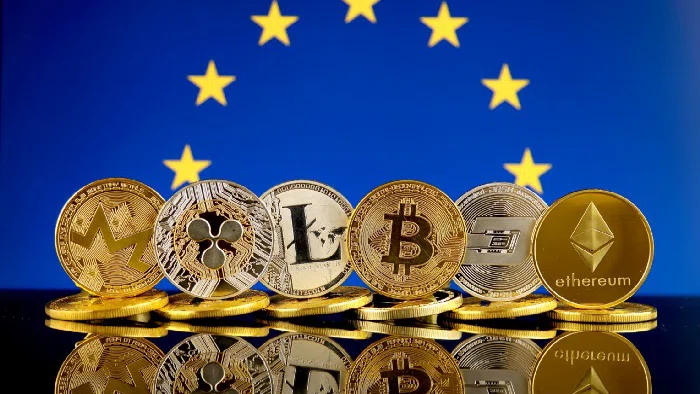The blockchain community should acknowledge: Regulation will be its great chance to go mainstream, because the mainstream business world won’t care otherwise about it – time to accept an inconvenient truth and embrace the new regulation.
The development of financial technology (FinTech) has led to significant advances in many areas. Some of the used technologies within the financial services industry include robotic process automation (RPA) and blockchain. Blockchain is another financial technology that is beginning to be used in the industry. Out of all the “fintech” technologies, blockchain was developed for finance purposes and directly tied to financial institutions.
The thing is, however, that the blockchain community still thinks it can do all of its own, meaning: It can change the world by providing so-called fantastic new business models and sustainable technology solutions through blockchain. But most people don’t get it and care even less. Blockchain is damn complicated. I’m a lawyer, and it took me a while to understand its concept and the opportunities it offers. Not saying I’m the brightest person around when it comes to technology, but I am sure as hell the kind of average Joe the blockchain community wants to address. But the blockchain community keeps mostly to itself, forming a bubble and telling each other how fantastic blockchain is. Inside the bubble, it’s all great; outside the bubble, few people truly care. Not only because the technology is tricky, but also because it is so damn not legally regulated. And mainstream companies won’t go into the unregulated territory. The risk is too high. No one cares for blockchain or crypto if their lawyers tell them it’s not safe, and the risk of getting your ass sued is too high. Sorry to break down this inconvenient truth.
Luckily, there’s some regulation coming around now. Especially the new EU regulation draft is fantastic for the blockchain community.
The subject of crypto assets is one of excitement and speculation. In addition to questions about further development and the already known volatility of the assets, there is the question of regulating the markets in crypto assets. Until now, individual countries in the European Union have been implementing their regulation policies for crypto assets. The greatest challenge in this context is the pursuit of the EU-wide regulation that contributes to harmonizing this new law area. In recent years there have been several attempts to create EU-wide regulation through recommendations and studies on behalf of the European Parliament and the European Commission. Outside of the context of the use of crypto-assets in an illegal context, two notable developments include the massive growth of the number of so-called private “tokens” issued on existing platforms to raise funds; and the emergence of so-called “stablecoins” and central bank digital currencies (CBDCs). These trends have caused various regulatory authorities, standard-setting bodies, and legal scholars to shift their focus and expand their vocabulary from the term “cryptocurrencies” to the broader term of “crypto-assets”. Let us have a look into the proposal for a REGULATION OF THE EUROPEAN PARLIAMENT AND OF THE COUNCIL on Markets in Crypto-assets (MiCA).
Proposal´s legal basis and key objectives / First major jurisdiction for cryptocurrencies
The EU regulation proposal is based on Article 114 TFEU, which gives the European institutions the competence to approximate legal provisions for the internal market´s establishment and functioning. By introducing a common EU framework, uniform operating conditions for companies in the EU market could be set.
The new rules´ goal is to provide legal certainty, support innovation, protect consumers and investors, and ensure financial stability and market integrity. The need to regulate at the EU level has also become more urgent given that some member states have started designing their own rules, including Germany, France, and Malta. EU´s Markets in Crypto-Assets (MiCA) draft legislation provides legal certainty around crypto assets – cryptocurrencies, security tokens, and stablecoins – the same lines as EU´s Markets in Financial Instruments Directive (MiFID), a legal framework for securities markets, investment intermediaries, and trading venues. European Union intends to treat crypto the same as any other regulated financial instrument, doubtless providing legal clarity. The long-awaited regulation will address the high volatility of cryptocurrencies, including Bitcoin, the most popular of these digital tokens, and the risks posed by systemic ones, like Libra. With the 167-page draft text, expected to be presented in the coming weeks, the EU will become the first major jurisdiction to regulate cryptocurrencies.
Specific provisions of the proposal
The proposed regulation will replace existing national frameworks applicable to crypto-assets not covered by existing EU financial services legislation and establish specific rules for stablecoins, including when these are e-money.
The material scope of the draft does not, however, include all types of crypto assets. Crypto assets that qualify as deposits, structured deposits, and securitization (Article 2) are deliberately excepted from the application scope. The exciting definition of “distributed ledger technology” or “DLT” (means a class of technologies that support the distributed recording of encrypted data) is informative in this context.
At the beginning of the legislative text (Article 3), the draft regulation introduces various crypto assets definitions. The new regulation meticulously differentiates between the three subcategories of crypto assets. The legislative split includes the legal provisions for utility token cryptocurrencies, complex “asset-referenced” stablecoins, and simple single currency stablecoins. In this context, the recognition of the regulator for simpler stablecoins is informative and detailed. The proposal assumes that they have functions like e-money – as previously defined in the Electronic Money Directive – and consequently pursue similar purposes because of their legal quality as electronic surrogates for coins and banknotes. However, not all stablecoins are comparable to e-money according to a right to redeem the money at par, which is required for e-money. To this end, the legislature is trying to align the regulation for this type of stablecoins with the law for e-money.
The regulator creates a catalog of obligations for the issuers of crypto assets. These issuers must be established as legal entities and act in a sincere, fair, and professional manner. The proposed obligations cover the entire process practically from the obligation to publish whitepapers (with all details and exemptions) with the obligatory disclosures – also contain general information about the issuer and the used technology – to regulate the assets´ exchange into the fiat currencies. Due to the extensive procedure and to facilitate access, the SMEs are exempted from this regulation, only where over 12 months the total consideration of the crypto-asset offering is less than €1 million (Article 4 para 2e). This regulation standard is also very welcome for developing technologies as such, especially for startups. Article 13 indicates that no asset-referenced tokens can be offered to the public in the European Union or admitted to trading on a trading platform for crypto-assets if the issuer is not authorized in the European Union and it does not publish a whitepaper approved by its competent authority. One of the unique features of this proposal is the creation of collateral for potential investors through the provision that an issuer shall only invest the reserve assets in secure assets, low-risk assets (as described by the electronic money directive) and that meets the definition of high-quality liquid assets under the Capital Requirements Regulation (Regulation EU 575/2013). Regarding the interpretation of whether the peculiarity “as significant” is given, the European Commission should be given a particular role. The Commission will be empowered to adopt a delegated act to specify the circumstances under which and thresholds above which an issuer of asset-referenced tokens will be considered significant. The issuers of such significant asset referenced tokens will be subject to additional requirements. These rules will include capital requirements (Article 16), interoperability (Article 24), and liquidity management policy (Article 19).
The regulatory work pays attention to e-money tokens (often described as “stablecoins”). The European Commission announced extensive regulation for stablecoins in its package of measures. Due to this type of token´s particular importance, the regulation places increased demands on their issue. Article 37 describes that no e-money tokens shall be offered to the public in the Union or admitted to trading on a crypto-asset trading platform unless the issuer is authorized as a credit institution or an “electronic money institution” within the meaning of Article 2(1) of Directive 2009/110/EC.
As a result, the responsibilities and monitoring mechanisms that are to apply uniformly across the EU are also created with corresponding authorization and supervision competencies (details on the power of competent national authorities) within the draft framework. The European Securities and Markets Authority (ESMA) & European Banking Authority (EBA) take a central role in this regulation and have essential roles, functions, and powers. ESMA, for example, shall establish a register of all crypto-asset service providers. Together with EBA, they have powers to issue technical guidelines and binding decisions, which are very pertinent, for example, when money tokens are concerned.
In doing so, the proposal will also have extensive consequences for services in digital assets. Although they will undoubtedly have a significant impact on the entrepreneurial landscape who are active cryptocurrencies and other digital assets, these proposed regulations bring more legal certainty and the desired improved investor protection, which is also one of this proposal´s aims.
EU contribution to the further development of blockchain technology
While a few Member States have already implemented a bespoke regime to cover some crypto asset service providers or parts of their activity, in most Member States, they operate outside any regulatory regime. The divergent frameworks and interpretations throughout the Union hinder the service providers’ ability to scale up their activity at the EU level. It results in high costs, legal complexity, and uncertainty in the crypto assets field and limits crypto-asset activities in the Union. The introduction of a common EU framework could reduce the complexity and costs and lead to market fragmentation and the rapid development of technology, which can also be used profitably in different sectors of the economy.
Outlook
The takeaway is that the EU intends to treat crypto the same as any other regulated financial instrument, doubtless providing legal clarity. In addition to providing legal certainty around all crypto assets, another core tenet of the proposed regulation is apparently to support innovation – and therefore the blockchain community. It illustrates that blockchain-based assets are the future of the EU financial markets, and trough the discussed proposal, it is welcome and acknowledged on the EU level. The proposal´s impact should be significant to support the development of blockchain-based solutions for critical financial organizations. It will help blockchain go mainstream. And if the blockchain community likes it or not, you are in goddamn need of that.
Want to learn more about blockchain and regulation for free? Join the global Blockchain Lawyers Network, created by the author.

